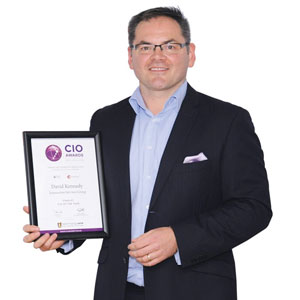THANK YOU FOR SUBSCRIBING

Increasing Salesforce User Adoption It Is Better To Give Than Receive
Chip Rowe, Senior VP, Salesforce Delivery Excellence, APN Insight


Chip Rowe, Senior VP, Salesforce Delivery Excellence, APN Insight
As a young man, many of us learned that it is much better to give than to receive. That same philosophy holds true when tackling the challenge of increasing Salesforce user adoption.
"In our discovery result, we found that salesforce was perceived as a 'Big Brother' and not a sales tool"
The Challenge
The world’s largest manufacturer and distributor of school team wear in the country (cheerleading squads, dance team squads, etc. ) required a redeployment of the Salesforce Sales Cloud system because Field Sales adoption metrics were falling far below what was needed to generate a projected Return On Investment.
The organization was facing a highly skeptical user community and there would not be a third chance to introduce Salesforce. The success of this re rollout was critical.
The Problem
Unreliable user adoption was having a downstream impact on the quality and timeliness of information whichthreatened the Salesforce investment.
Field sales reps were expected to use Salesforce to enter all sales call information and notes, sales opportunities, associated products, cheer and dance squad changes, sponsors, participants, new schools, school district reorganizations, changes in potential order volumes, and all while being asked to spend six to eight weeks every year manually preparing a sales forecast and call plan for the following year outside of Salesforce.
The Discovery Process
To get to the heart of their adoption challenge,we anonymously interviewed various members of the Sales Team, from high performers through marginal performers, and ask three basic questions:
1. What parts of Salesforceare helpful?
2. What parts of Salesforceare considered unhelpful?
3. What do you need Salesforce to provide you to better manage your book of business and achieve your quota?
We also interviewed various members of the management team to ask 3 basic questions:
1. How often are you using Salesforce to evaluate sales performance?
2. Is there any information important to management that is still being createdby sales outside of Salesforce?
3. What do you need Salesforce to provide you to help manage your sales team performance?
The Discovery Results
1. Salesforce was perceived as a“Big Brother” and not a sales tool. Most managers were not using Salesforce to discuss call plans and call results with their field sales people. A comment heard often was “If my manager isn’t using Salesforce, why should I.”
2. Entry of sales informationproviding no benefit back to reps. Even though they felt that capturing some of the information was vital to long term success, the common complaint from reps was, "I wasn't hired to be a data entry clerk."
3. The time required for a rep to prepare for the critical year end budget review sales call with a school required access to a back office order system to manually extract and organize previous order information which took between 1 to 2 days for each scheduled review.
4. Yearly Forecasting by field sales reps was required to be developed squad by squad, school by school. This manual preparation of the yearly forecasts was considered by everyone to be highly inefficient and robbed the sales team of vital selling time. The tedious and time consuming task of entering the previous year’s sales data into an Excel workbook template was error prone and took 6-8 weeks of effort per rep. Reps were also required to manually create an Opportunity record with previous year product volumes for each squad as part of their account contact planning.
5. When completed, the forecasts were sent by each field sales rep to their Sales Manager for manualconsolidation of their team’s numbers, who would forward consolidations to the Regional Manager for consolidationinto territories, who would forward their information to the Vice President, who would consolidate and modify the final forecast before sharing itwith the product production team. This process was considered to be only about 60% accurate with no ability to confidently evaluate updates to the forecast during the year.
The Solutions
1. All prior year order detail is automatically imported into a custom Order object in Salesforce and associated to each squad, which automatically rolls up to school, district and school board level.
2. Summary fields were created providing at a glance total current year versus last year order volumes.
3. Field sales reps are using product summary reports of all products previously ordered at anysquad, school, district or School Board level by clicking a report link inside the account record. This facilitates “on-demand” order and budget reviews with school officials.
4. A Visual Force page was built that allowed forecasting inside Salesforce at the product level by aligning products ordered the previous year with the forecasted sales. Variations in order volumes are color coded. Green volumes mean more of that product was ordered than forecasted and red means the opposite. Forecasts are automatically summarized for everyone, eliminating the use of Excel spreadsheets. Additionally, forecast accuracy versus sales volume is displayed using dashboards.
5. Salesforce Opportunities are created automatically and populated with the products ordered the previous year. All sales activities are associated with each respective opportunity and adjustments to product volumes, sales prices, and addition of new products are tracked at individualOpportunity product levels. Dashboards are built to display actuals to forecasted sales, and actual sales to quota.
6. Incentives for accurate and complete information were established and the company adopted the philosophy that "If it’s not in Salesforce It didn't happen."
7. A Salesforce AppExchange transcription service was established for each rep eliminating manual data entry, increasing timeliness of information, and facilitating the use of iPad tablets for account management rather than laptops.
8. Google maps functionality was added to help Reps locate their schools and contacts near an existing appointment so sales call rescheduling efficiency was increased.
9. All “fitting day”,information is now collected using the IPad tablets, eliminating the need for paper based records. Order status is tracked on the Tablet, as well.
The Results
1. User adoption of Salesforce has increased 100%.
2. Time spent preparing yearly Forecasts was reduced from 6-8 weeks to 1 week.
3. Accurate entry of sales activity information and notes increased by an estimated 85% - 90% with all activity reviews conducted inside Salesforce.
4. Previous year order reviews with Sponsors and School Administrators are conducted in real time and have reduced prep time from 1 to 2 days down to 1 hour.
5. Accuracy of sales forecasting has increased 88%.
6. New school market share has increased 78%.
Certainly it is better to give than to receive.
Weekly Brief
I agree We use cookies on this website to enhance your user experience. By clicking any link on this page you are giving your consent for us to set cookies. More info
Read Also
Microsoft-Covering People 360 Degrees...
How Insurers Can Lead Digital Ecosystems and Better Meet Customer Needs Platforms Such as Microsoft Azure Can Help Companies Become Network Orchestrators
Balancing Innovation with Stability in the Quick Service Restaurant Sector
AI at the Table: Simulating Stakeholder Voices in Policy Design
Where Technology Meets Tradition in Sports
Why Software Delivery Centres Fail In Insurance
Building Smarter Content Systems for Scalable Growth
The Thoughtful Innovation behind Every Loaf




















